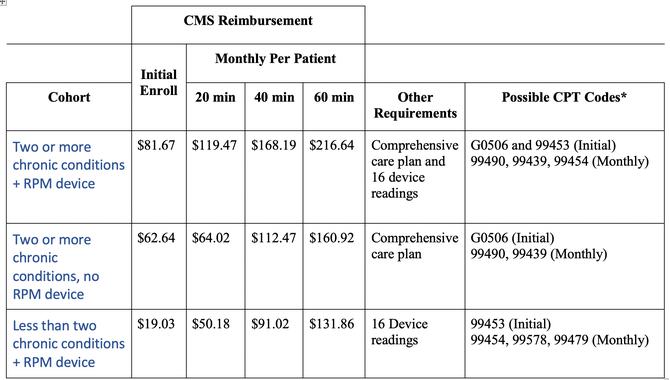Care management services are reimbursable remote medical services that provide ongoing care to patients between traditional or remote doctor's office visits. Such services include chronic care management (CCM), remote patient monitoring (RPM), behavioral health integration (BHI), and many others, with even more services emerging regularly.
Since their inception, care management services have largely been conceptualized as a series of discrete services that are implemented separately from each other and other telehealth services. Since the COVID-19 public health emergency began, Medicare and other payers have permanently widened the scope and increased the reimbursement of care management programs, supporting the creation of multi-service wellness programs that improve patient outcomes and engagement. These developments have also provided fee-for-service healthcare organizations with a strong, recurring source of revenue and risk-sharing organizations with substantial savings.
This column will largely focus on the economics of creating and implementing a comprehensive care management program. But before diving into this subject, I thought it may be helpful to provide some clarification regarding common misunderstandings surrounding care management programs, telehealth, and telemedicine.
We begin with a note about telehealth: Telehealth as a term encompasses the full spectrum of remote healthcare, including virtual visits, care management services, health applications, and connected medical devices. The ability to manage patients outside of the confines of an office has always promised to change the course and accessibility of modern medicine, and the pandemic has prompted much faster adoption than anyone could have anticipated.
Care management services are an important aspect of telehealth, yet the services are often thought as discrete, as noted above. It is becoming clearer that such conceptualization does a disservice to patients and providers. For patients, this interpretation is causing confusion about the value of care management services, why they are worth enrolling in and, when required, why they are worth paying co-insurance for. For many providers, the increasing number of care management service types creates uncertainty around value and investment, and how to fit care management into their organization's workflow and goals.

As will be discussed, there is substantial value to providers and patients in implementing care management services as a more fluid set of tools in an overall comprehensive patient care program — essentially an à la carte menu that can be tailored to provide patients with care management they need in timelier and more efficient manner. Such a program is not just beneficial for patients. With the recent coverage and reimbursement changes, a comprehensive care management program can also make a significant difference in a healthcare organization's bottom line.
The issuing of the 2022 Physician Fee Schedule (PFS) final rule made it even more apparent that organizations seeking to expand or implement patient care management programs will be best served by taking a comprehensive approach — one that allows patients to receive a wider range of services tailored to their individual needs while better ensuring reimbursement for all aspects of those services.
These terms all speak to a program that combines the offering of CCM and RPM services, which are sometimes supplemented by additional care management and preventive services. Regardless of how you describe the program, developing such a program can deliver significant benefits to patients and providers. For patients, a comprehensive care management program will help them receive more timely, personalized, preventive care that contributes to overall better health and improved access to care. This naturally translates to fewer hospitalizations and readmissions as well as lower costs for patients and the healthcare system.
That alone makes offering comprehensive care management to your patients worthwhile. But the thick icing on the cake is that by combining CCM, RPM, and, when appropriate, other patient-specific care management services, the bottom line of organizations will benefit from a consistent, high-revenue-generating service. That's the focus of this column.
To help you gain a better understanding of the economics behind a comprehensive care management program, we're going to take a high-level look at the three most common patient cohorts that would be covered under such a program. We'll discuss how CCM and RPM services would apply to these cohorts and how these services are currently covered and reimbursed by Medicare.
This first patient cohort is likely to reflect the most common comprehensive care management service opportunity: a patient with two or more chronic conditions receiving CCM services whose health and wellness is further supported by an RPM device.
Consider that data show nearly 70% of Medicare beneficiaries have two or more chronic conditions, with the most common including hypertension, obesity, congestive heart failure, chronic obstructive pulmonary disease, and diabetes. These beneficiaries would be eligible for CCM services.* This includes the development of a comprehensive, patient-specific care plan with goals and then ongoing, monthly support to help patients achieve those goals and reduce the need for additional healthcare services.
If one of the chronic conditions can be supported by an RPM device, such as a blood pressure monitor, weight scale, blood glucose meter, or pulse oximeter, organizations can provide patients with a device and bill for furnishing RPM services. This includes providing the device to beneficiaries and educating them on its use, and then the ongoing capture and review of device-transmitted data.
